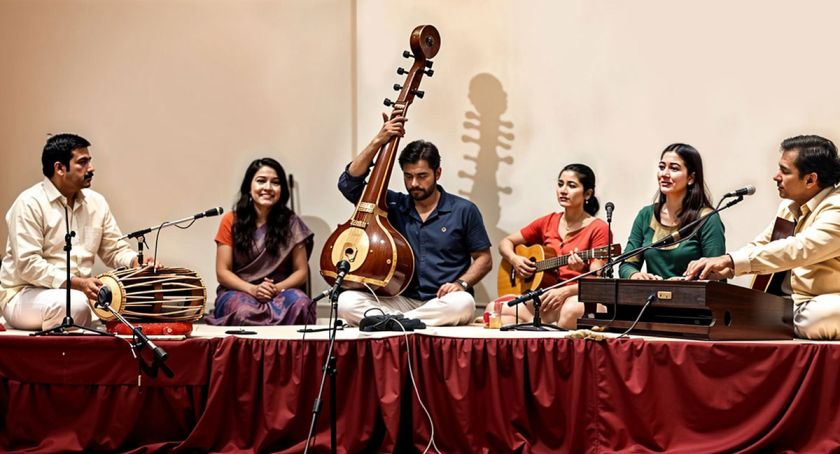The Divine Melodies of Odissi Music
Odissi music, an integral part of the classical Odissi dance tradition, is one of India’s oldest and most revered classical music forms. Odissi music, which has its roots in the culturally diverse state of Odisha, combines melody, rhythm, and spiritual depth distinctively. Its roots trace back to ancient temples, where it flourished as an offering to deities. Over time, it has evolved into a sophisticated musical genre, celebrated for its devotional fervor and complex compositions.
In this blog, we will see the fascinating world of Odissi music, delving into its history, characteristics, styles, and modern significance.
The Historical Background of Odissi Music
Originated in the ancient temples of Odisha, where it played a vital role in rituals and devotional practices. It evolved through three main traditions: the Mahari Tradition, where temple dancers (Maharis) performed it as an offering to Lord Jagannath; the Gotipua Tradition, where young boys dressed as female dancers showcased Odissi music and dance outside temples; and the Natyashastra Influence, which shaped its classical structure based on Bharata’s treatise. Renowned poets and saints like Jayadeva, Kavisurya Baladev Rath, and Upendra Bhanja enriched this tradition with their timeless compositions.
Key Characteristics of Odissi Music
It stands out for its distinctive features that set it apart from other classical traditions. Its unique melody, rhythm, and improvisation blend to create a profoundly expressive and spiritual musical experience.
- Unique Melodic Structure: Unlike Hindustani and Carnatic, Odissi music follows a distinct melodic structure. It employs the Odissi raga system, which differs from the North and South Indian classical ragas in its rendition and movement. The compositions exhibit a lyrical flow, often reflecting Odisha’s natural beauty and cultural ethos.
- Tala System and Rhythm Patterns: It follows a unique Tala (rhythmic) system, incorporating complex rhythmic cycles such as Ektali, Khemta, and Jhampa. The percussion instrument Mardala is central to maintaining rhythm in Odissi performances, adding a dynamic yet graceful touch to the compositions.
- Vocal Styles and Improvisation: It is primarily vocal-centric, with a rich repertoire of ragas and talas that allow room for improvisation. It balances strict compositions and creative improvisation, enabling musicians to showcase their expressive depth.
Forms and Genres of Odissi Music
Odissi music encompasses a variety of forms, each with its unique structure and thematic focus:
- Chhanda: Chhanda compositions are metrical and rhythmically rich, often performed with vibrant percussion accompaniment. People commonly sing them in praise of deities.
- Chaupadi: Chaupadi are free-flowing lyrical compositions focusing primarily on love, devotion, and moral values. Odia poetry and folk traditions often inspire the lyrics.
- Champu: Champu is a unique genre in which each stanza begins with a particular letter of the Odia alphabet, forming an acrostic composition. This poetic style showcases Odissi music’s linguistic and literary excellence.
- Bhajan and Janana: Bhajans (devotional songs) and Jananas (hymns) are soul-stirring compositions that invoke divine emotions. These are sung at festivals and religious events, creating a strong spiritual bond with the listeners.
- Padi: Padi compositions are fast-paced and rhythmic, often used in dance performances. They help maintain the tempo and provide a dynamic element to Odissi music.
Instruments Used in Odissi Music
Traditionally, instruments are crucial in shaping Odissi music’s distinctive sound and rhythm.
- Mardala: The Mardala, a double-headed percussion instrument, is the backbone of music. It produces complex rhythmic patterns and adds dynamism to musical and dance performances.
- Veena: The Veena, a stringed instrument, produces melodic accompaniments in music. It enhances the depth of compositions by adding a resonant quality to the renditions.
- Flute: The flute is another prominent instrument in Odissi music, often used to create soothing and expressive melodies that complement the vocal renditions.
- Manjira and Ghungroo: Manjira (small cymbals) and Ghungroo (ankle bells) help maintain rhythm and add a percussive texture to the performances.
The Role of Odissi Music in Odissi Dance
Music and dance share an inseparable bond. The compositions provide the melodic and rhythmic foundation for Odissi dance performances. The dancers synchronize their complex footwork and graceful movements with the beats of Mardala and the fluid melodies of Odissi ragas. This synergy makes Odissi a holistic art form that transcends mere performance and becomes a spiritual experience.
Notable Composers and Exponents
Several legendary musicians and composers have contributed to the growth and preservation of Odissi music:
- Jayadeva: The 12th-century poet who composed the famous Gita Govinda, a cornerstone of music.
- Kavisurya Baladev Rath: Celebrated for his poetry and Champu works.
- Pandit Raghunath Panigrahi: A celebrated Odissi musician and vocalist known for his soulful renditions.
- Guru Kelucharan Mohapatra: Though primarily a dancer, he played a significant role in integrating Odissi music with dance.
Final Thoughts
It is a classic art form that never fails to uplift and inspire its audience’s spiritual awareness. With its distinctive ragas, soulful melodies, and deep devotional essence, Odissi music remains a significant cultural treasure of India. We can guarantee that this rich musical legacy will endure and enthrall listeners for generations by encouraging and supporting it.
Much like its dance counterpart, it is an expression of divinity and artistic excellence. As more musicians and enthusiasts embrace its beauty, this classical tradition will continue to flourish, echoing the spiritual legacy of Odisha across the world.


